How to Dispose of Needles
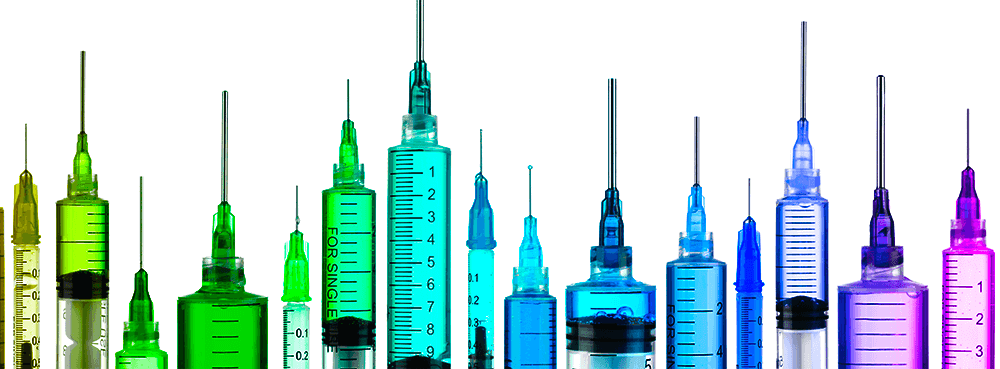
Needles are indispensable tools in healthcare, it’s unlikely you’ll go a day in the workplace without encountering them, but they pose significant risks when mishandled. Knowing how to dispose of needles safely is crucial for protecting healthcare workers, patients, and the environment.
Whether you work in a hospital, veterinary clinic, or dental practice, this easy-to-digest guide will equip you with the essential knowledge to prevent accidents, comply with regulations, and safeguard public health.
Let's delve into the critical steps for safe needle disposal.
TOPICS WE WILL COVER:
1 / How to dispose of needles: safe handling and disposal procedures
2 / Choosing the right container for your needle waste
3 / Are you looking for the safest way to dispose of needles?
How to Dispose of Needles: Safe Handling and Disposal Procedures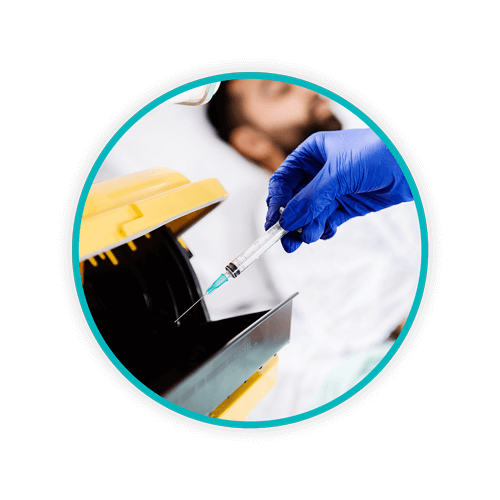
Needle-less to say, the first step to the safe disposal of needles is understanding what sharps waste is, once you have that solid foundation in place you’re ready to dive into our concise guide for clinical staff on how to dispose of needles within the healthcare setting:
Locate the correct sharps container
- Sharps containers should be readily available at the point of use* – either on dispensing trolleys, treatment carts, or designated wall mounts.
- Never walk around with a used needle searching for a container.
Immediately dispose of the needle
- Once you’ve finished using the needle and syringe, immediately dispose of them together in the correct sharps container.
Always avoid: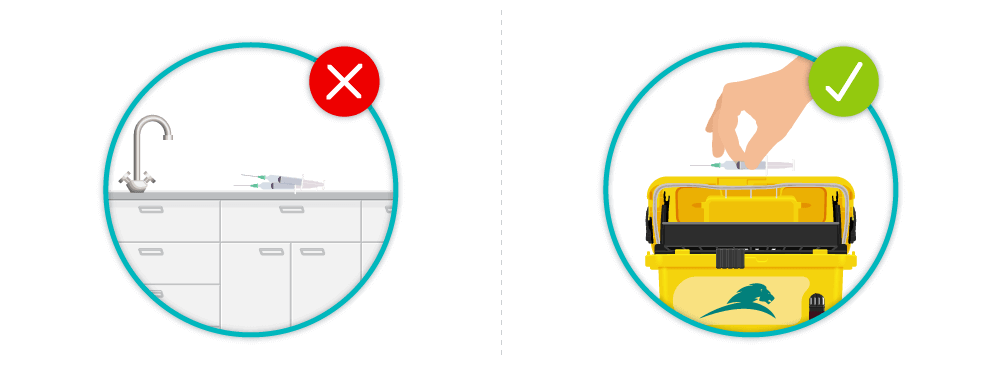
- Recapping the needle.
- Bending, breaking, or trying to blunt the needle.
- Placing the used needle anywhere other than the sharps container.
Securely close the sharps container
- After placing the needle and syringe inside, firmly close the sharps container lid, ensuring a snug fit to prevent accidental punctures or spills. (Sharpsmart reusables have an in-built safety tray that enables even the lightest sharps to be self-deposited into the container – reducing the risk of “protrusion” sharps injuries and restricting hand access.)
Check the fill level
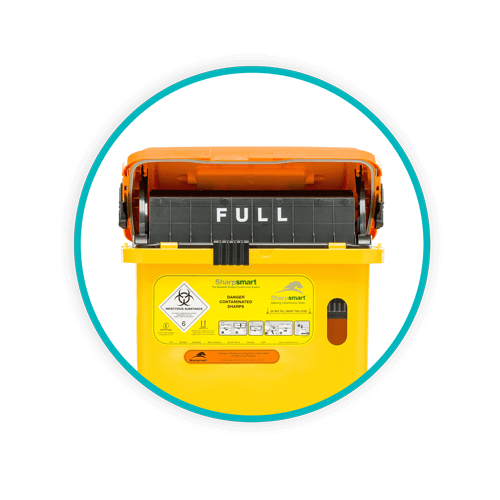
- Regularly monitor the fill level of the sharps container.
- Never overfill the sharps container. Stop using it as soon as the sharps reach the designated fill line, usually marked on the side or through a clearview window.
Full sharps container? Request a replacement
- Once the sharps container is full, a new, empty one will be needed to replace it.
- Follow your facility’s specific procedures for requesting a new container from designated personnel or replacing it yourself.
By following these simple steps, you can ensure the safe disposal of needles in any healthcare environment, minimising the risk of needlestick injuries (NSIs) and protecting yourself, your colleagues, and your patients.
If you have any questions related to disposing of needles or if you’re looking for support with your sharps waste disposal, we’re here to help.
Now that you have the safe handling and disposal procedures down, it’s time to consider choosing the right container.
*For healthcare workers in situations without dedicated work areas (e.g. paramedics or home care providers) the focus is on using appropriate portable sharps containers. These containers will be determined by your employer’s risk assessment, ensuring their suitability for the specific setting and means for collection and replacement.
Choosing the Right Container for Your Needle Waste
There are two ways of viewing this section: choosing the right container for your needle waste, and choosing the right container for your needle waste…
When disposing of needles, using the correct container according to the colour-coding system outlined in the Healthcare Technical Memorandum (HTM) 07-01 is essential from both a compliance and safety standpoint.
The sharps container colour-coding you need to be aware of is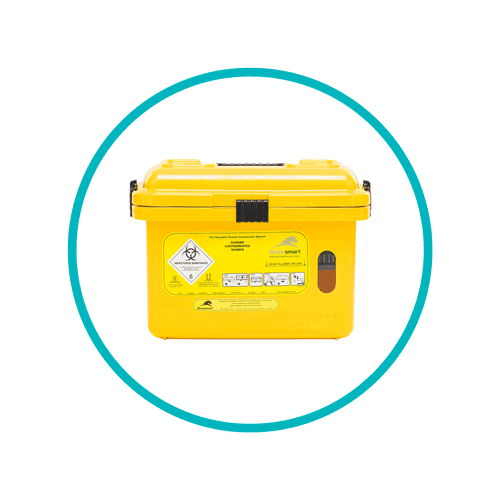 :
:
- Yellow lid: Sharps contaminated by a medicine other than cytotoxic and/or cytostatic components – may also include vials, ampoules, or medicine bottles.
- Purple lid: Sharps contaminated with cytotoxic and/or cytostatic medicines.
- Orange lid: Sharps that haven’t been contaminated with a medicinal product.
Now for part two of choosing the right container…
You want to be sure you’re using the safest type of container – a clinically engineered safety device proven to reduce needlestick injuries (NSIs) and make the healthcare environment safer for staff and the public. Why settle for anything less?
One such device, in fact, the device that set the compliance standards for reusable sharps containers in the first place is the Sharpsmart reusable container.
With up to 87% reduction in needlestick injuries (NSIs), our reusable sharps container is recognised as the world's safest sharps containment system by industry experts and leading professionals in microbiology and infection control.
Here are some of the other ways it can benefit you:
They allow for easy, point-of-use disposal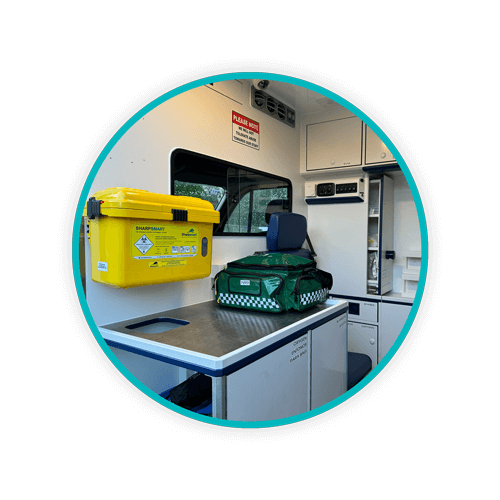
Designed for convenience, Sharpsmart reusable containers optimise space and enhance safety in any healthcare setting, including ambulances.
By having a safe disposal option at the point of generation, you can eradicate the risks associated with carrying a sharp to a bin.
They protect against overfilling and hand entry
As mentioned earlier, the inbuilt safety tray prevents hand access to sharps contents and protects against overfilling by closing once the safe full level is reached.
They reduce your carbon footprint and save you money
Sharpsmart reusables are certified for 500 uses with an average lifespan of over 65 years, minimising environmental impact throughout the full lifecycle and realising significant cost savings by supporting waste stream optimisation and waste reduction.
And what happens when they reach the end of their life? Warning: Spoiler alert!
They live on…
Discover the full life journey of our reusable sharps containers by reading our blog on the subject.
So, how will you be disposing of needles?
Are You Looking for the Safest Way to Dispose of Needles?
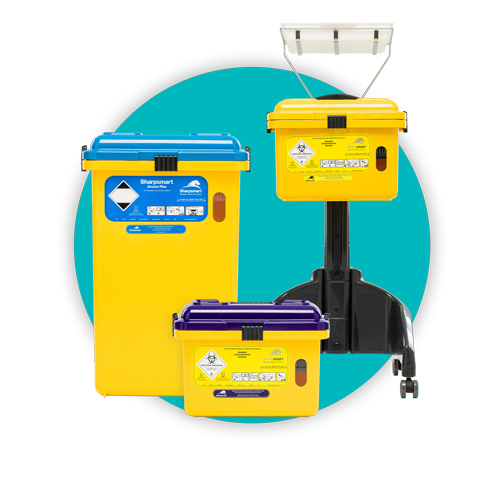 With Sharpsmart you get far more than bins and a collection service. We work with clinical staff within the four walls of healthcare to ensure your waste is being managed and optimised safely, efficiently, and in compliance with regulations.
With Sharpsmart you get far more than bins and a collection service. We work with clinical staff within the four walls of healthcare to ensure your waste is being managed and optimised safely, efficiently, and in compliance with regulations.
Our sharps waste disposal solution is a fully managed service that includes training healthcare workers on correct segregation and best practices, reducing risks and protecting staff and the public.
If you’d like more information, need guidance on where to dispose of needles, or want to introduce the world’s safest sharps containers into your organisation, get in touch.
